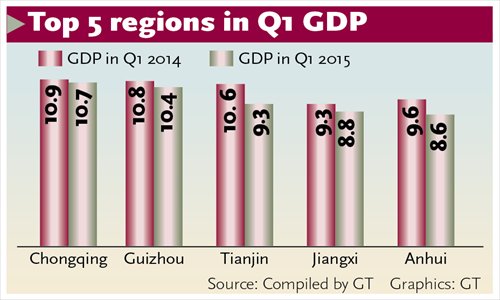
Most areas report Q1 slowdown
A total of 25 provinces, autonomous regions and municipalities had released their first-quarter GDP data as of Sunday, with 22 of them reporting a year-on-year slide in growth amid continued economic headwinds.
Only two regions - North China's Hebei Province and Northwest China's Ningxia Hui Autonomous Region - reported higher GDP growth than in the first quarter of 2014, the data showed.
The GDP growth rate in South China's Guangdong Province, meanwhile, was 7.2 percent in the first quarter, the same as in the first quarter of 2014, according to statistics released by the Guangdong Provincial Bureau of Statistics on April 20.
Experts said that the GDP statistics are in line with China's overall macroeconomic situation.
"The figures reflect slower GDP growth rates in the 'new normal' period," Wu Hong, director of the School of Economic Law at the East China University of Political Science and Law, told the Global times on Sunday.
But Wu also noted that seasonal factors should be taken into consideration when analyzing the data, adding that GDP growth may pick up in the rest of the year.
"In the first three months of 2015, including the Spring Festival holidays, China's economic growth might be a bit slower than at other times of the year," said Wu.
Yuan Zhigang, a professor with the School of Economics at Fudan University, told the Global Times on Sunday that the gloomy economic figures could have been caused by declining investment in manufacturing and in the real estate industry in China.
But he also stressed that investment in China's infrastructure construction is expanding, thanks to the "One Belt, One Road" initiative and to the central government's fiscal policies.
The total economic value of the infrastructure projects detailed by all local governments at China's two sessions in March is 1.04 trillion yuan ($168 billion), according to a Beijing News report on Friday.
Yuan also said the influence of the "One Belt, One Road" initiative on China's economic performance is not likely to be reflected in short-term economic figures. "The effect of infrastructure investment on China's economy could be shown in two or three years," he noted.
Wu pointed out that economic development in Hebei is likely to remain healthy, given the government's plan to push for coordinated development in the Beijing-Tianjin-Hebei area.
"The GDP growth in Hebei has been boosted by the increased amount of investment in infrastructure projects, and a number of those projects are part of the regional development plan," said Wu.
Hebei Province saw a substantial increase in its year-on-year GDP growth rate, rising from 4.2 percent in the first quarter of 2014 to 6.2 percent in the first three months this year.
The Beijing News report also said that cities in the middle reaches of the Yangtze River had "relatively high" GDP growth rates. For instance, the GDP of Jiangxi, Hubei, Anhui and Hunan provinces grew by 8.8, 8.5, 8.6 and 8.4 percent year-on-year in the first quarter of 2015, respectively.
Wu said that slow recovery in the global economy was not affecting China's inland provinces such as Jiangxi and Hubei as strongly as the more export-oriented coastal regions.
"Support from government policies, such as the plan to develop city clusters along the middle reaches of the Yangtze River, could also boost economic growth in this area," said Wu.
Shanxi Province saw GDP growth of 2.5 percent year-on-year in the first quarter of 2015, the lowest figure among the 25 provincial regions.
Zhang Ye, senior researcher at steel industry information portal custeel.com, told the Global Times on Sunday that the economy of Shanxi is too reliant on coal, and the decline in production and sales revenue in the industry has hit growth in the province.
Six provincial regions, including the three provinces in Northeast China -Heilongjiang, Liaoning and Jilin - and Southwest China's Tibet Autonomous Region, have not yet revealed their first-quarter GDP data.
















































